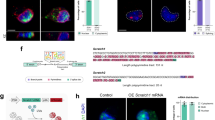Abstract
Arterial endothelial cells (EC) at the adult stage differ from capillary and venous EC in terms of resistance to stress; however, the molecular basis of this resistance is not clear. Here, we found that arterial EC are highly resistant to bone morphogenetic protein (BMP)4-dependent apoptosis, whereas capillary and venous EC are not. The expression of inhibitory Smads (I-Smads) in arterial EC was well correlated with the resistance to this apoptosis. After the knockdown of I-Smad expression by short interfering RNA, the resistant arterial EC became sensitive to BMP4. In contrast, the ectopic expression of I-Smads in BMP4-sensitive cells suppressed BMP4-induced apoptosis. Furthermore, intravenous administration of BMP4 into mice caused hemorrhage of capillary EC in brain and lung. These results strongly suggest that BMP4/I-Smads are a novel regulator for the stability of vascular EC.
This is a preview of subscription content, access via your institution
Access options
Subscribe to this journal
Receive 50 print issues and online access
$259.00 per year
only $5.18 per issue
Buy this article
- Purchase on Springer Link
- Instant access to full article PDF
Prices may be subject to local taxes which are calculated during checkout





Similar content being viewed by others
References
Bourdeau A, Faughnan ME, Letarte M . (2000). Trends Cardiovasc Med 10: 279–285.
Duff SE, Li C, Garland JM, Kumar S . (2003). FASEB J 17: 984–992.
Graham A, Francis-West P, Brickell P, Lumsden A . (1994). Nature 372: 684–686.
Gu K, Smoke RH, Rutherford RB . (1996). Arch Oral Biol 41: 919–923.
Hanyu A, Ishidou Y, Ebisawa T, Shimanuki T, Imamura T, Miyazono K . (2001). J Cell Biol 155: 1017–1027.
Hata A, Lagna G, Massague J, Hemmati-Brivanlou A . (1998). Genes Dev 12: 186–197.
Herzog Y, Kalcheim C, Kahane N, Reshef R, Neufeld G . (2001). Mech Dev 109: 115–119.
Imamura T, Takase M, Nishihara A, Oeda E, Hanai J, Kawabata M et al. (1997). Nature 389: 622–626.
Ishisaki A, Yamato K, Hashimoto S, Nakao A, Tamaki K, Nonaka K et al. (1999). J Biol Chem 274: 13637–13642.
Kimura N, Matsuo R, Shibuya H, Nakashima K, Taga T . (2000). J Biol Chem 275: 17647–17652.
Kiyono M, Shibuya M . (2003). Mol Cell Biol 23: 4627–4636.
le Noble F, Moyon D, Pardanaud L, Yuan L, Djonov V, Matthijsen R et al. (2004). Development 131: 361–375.
Massague J . (1998). Annu Rev Biochem 67: 753–791.
Moyon D, Pardanaud L, Yuan L, Breant C, Eichmann A . (2001). Development 128: 3359–3370.
Nakao A, Afrakhte M, Moren A, Nakayama T, Christian JL, Heuchel R et al. (1997). Nature 389: 631–635.
Patan S . (2004). Cancer Treat Res 117: 3–32.
Shawber CJ, Das I, Francisco E, Kitajewski J . (2003). Ann NY Acad Sci 995: 162–170.
Shibuya M . (2001). Cell Struct Funct 26: 25–35.
Shibuya M, Ito N, Claesson-Welsh L . (1999). Curr Top Microbiol Immunol 237: 59–83.
Shin D, Garcia-Cardena G, Hayashi S, Gerety S, Asahara T, Stavrakis G et al. (2001). Dev Biol 230: 139–150.
Souchelnytskyi S, Nakayama T, Nakao A, Moren A, Heldin CH, Christian JL et al. (1998). J Biol Chem 273: 25364–25370.
Topper JN, Cai J, Qiu Y, Anderson KR, Xu YY, Deeds JD et al. (1997). Proc Natl Acad Sci USA 94: 9314–9319.
Wang HU, Chen ZF, Anderson DJ . (1998). Cell 93: 741–753.
Yancopoulos GD, Klagsbrun M, Folkman J . (1998). Cell 93: 661–664.
Zou H, Niswander L . (1996). Science 272: 738–741.
Acknowledgements
We thank Dr K Miyazono for kindly providing us with plasmids pcDNA3-FLAG-Smad6 and pcDNA3-FLAG-Smad7. This work was supported by Grants-in-Aid for Special Project Research on Cancer-Bioscience (12215024, 17014020) from the Ministry of Education, Science, Sports and Culture of Japan and for the program ‘Research for the Future’ of the Japan Society for the Promotion of Science and the program ‘Promotion of Fundamental Research in Health Sciences’ from the Organization for Pharmaceutical Safety and Research (OPSR).
Author information
Authors and Affiliations
Corresponding author
Rights and permissions
About this article
Cite this article
Kiyono, M., Shibuya, M. Inhibitory Smad transcription factors protect arterial endothelial cells from apoptosis induced by BMP4. Oncogene 25, 7131–7137 (2006). https://doi.org/10.1038/sj.onc.1209700
Received:
Revised:
Accepted:
Published:
Issue Date:
DOI: https://doi.org/10.1038/sj.onc.1209700
Keywords
This article is cited by
-
VEGFR2 activation mediates the pro-angiogenic activity of BMP4
Angiogenesis (2019)
-
BMP4/Thrombospondin-1 loop paracrinically inhibits tumor angiogenesis and suppresses the growth of solid tumors
Oncogene (2014)
-
Over-expression of BMP4 inhibits experimental choroidal neovascularization by modulating VEGF and MMP-9
Angiogenesis (2012)
-
A predicted functional single-nucleotide polymorphism of bone morphogenetic protein-4 gene affects mRNA expression and shows a significant association with cutaneous melanoma in Southern Italian population
Journal of Cancer Research and Clinical Oncology (2009)



